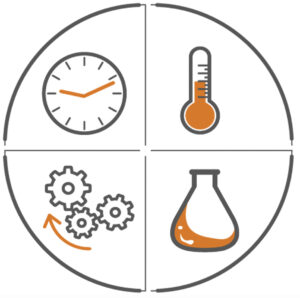Effective cleaning with CIP (Clean-in-place)
Contaminants (dirt) represent a major challenge for food producers. Dirt in the form of product residues consists of many different components, and if the process includes heating or cooling it becomes even more challenging to clean the plant. Most food production plants must be cleaned on site, between production cycles. This type of cleaning is called Clean-in-place (CIP).
Failure to completely clean the plant can lead to microbial growth of microorganisms such as bacteria and fungi. To ensure the avoidance of microbial growth and the handling of food using a safe and high-quality process, it is necessary to continuously clean and disinfect the equipment.
The four factors of cleaning
When you clean plant that is used for food production, there are several factors that impact the results. These factors are mechanical processing, temperature, chemical concentration and time. How these factors interact and affect cleaning processes is illustrated in a model called Sinner’s Circle.

Mechanical processing could, for example, be high-pressure rinsing or brushing, while the chemical concentration could affect the ability of the chemicals to dissolve dirt. The temperature during the cleaning process is important, as dirt is dissolved more easily and can be more easily
removed from surfaces if the temperature is higher. The duration of the cleaning process also has an impact on the results.
Interrelationship between the four factors
The four factors are like pieces of cake in a circle. If one of them is reduced (if, for example, it is not possible to use chemicals), one or more of the other factors must be increased in order to achieve the same result (for example, more mechanical processing for a longer time). When all 4 of these factors are satisfactorily met, it is possible to guarantee a quality-assured food production process. It is also equally important to continuously monitor the results of the cleaning process and to keep the equipment in good condition through a good maintenance strategy.
The following checklist provides a good guide to the achievement of good cleaning results at a food production plant.
- Rinsing with cold water. This removes large particles and product residues so that they don’t clog up or impair the cleaning process, while also enabling the chemical solution to come closer to the surfaces that must be clean.
- Rinsing with hot water. Dirt has different properties at different temperatures – at higher temperatures it dissolves more easily and is more easily removed from the surfaces that must be clean. The temperature is particularly important when it comes to dried product residues and microbiological residues. To put it simply: the higher the temperature you use, the quicker the process will be.
- Chemical cleaning. When the visible dirt has been removed from the plant, the chemical solution has the best conditions to do its job effectively. The chemical solution penetrates behind and dissolves the invisible biofilm of product residues that remains after the initial rinsing phases.
- Rinsing with hot water. This phase removes the dissolved product residues that may still be present in the plant, as well as any residues of the chemical solution. The temperature and water pressure are crucial factors in determining how long this phase should continue.
- Rinsing with cold water. This phase cools down the plant and also removes the last remaining residues of the chemical solution. The cooling process is important, as warm surfaces attract moisture from surrounding surfaces that have not yet been cleaned, and this could lead to contamination of the recently cleaned surface, which would entail a risk of microbiological growth.
- Chemical disinfection. This final phase ensures that the equipment is sterile. The disinfectant makes it difficult for microbiological growth to start.
Chemicals
Cleaning chemicals ensure that dirt and product residues are dissolved and can be rinsed away. There are many different substances and combinations within the food industry. Without chemicals it would quite simply not be possible to effectively clean certain bacteria from equipment. Anaerobic and aerobic bacteria are everywhere and are very capable of finding surfaces on which to rest.
Within food handling and CIP it is necessary to use alkaline chemical solutions to dissolve organic materials. Inorganic materials can easily be removed with water, but organic residues require a concentration of alkaline or chlorine-based chemicals.
As a general rule, the use of lye-based chemicals is advocated. Lye is alkaline and has good properties for dissolving product residues. That said, it may be difficult for lye-based chemicals to remove flavours and odours from the inside of plant. Disinfectants with foam-based chemicals can be used directly on the external surfaces of the plant, although these types of disinfectants do not usually reach the inside of pipes and other difficult locations.
It is important to choose the right disinfectant chemical, and it is important to choose the right chemical based on the material that exists in the equipment. Gaskets and other machine parts are affected in different ways by different chemicals. For example, chlorine could give rise to corrosion, even on certain types of stainless steel. Many factors affect the choice of the best and most suitable chemicals, and a sound piece of advice is to always consult with the supplier of the chemicals regarding your specific needs and circumstances.
Would you like to know more about how the team at Qestio can help you analyse the potential savings in your production plant and support you in the implementation of necessary changes? Contact us!
